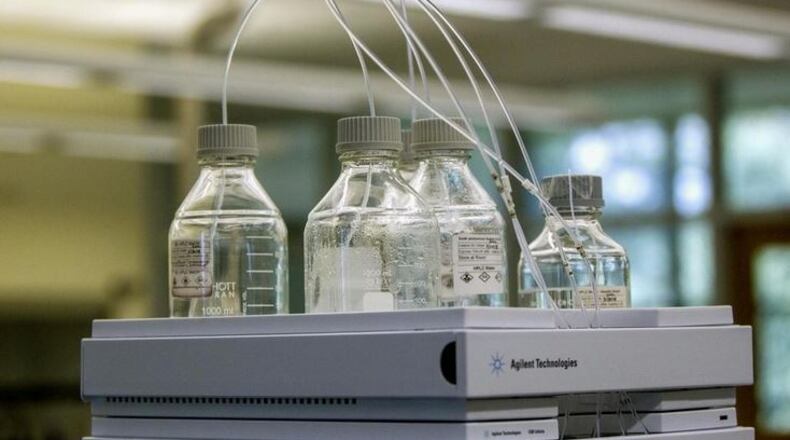Dayton has been looking at ways to reduce or eliminate the migration of PFAS-tainted groundwater and treat its water supply to remove the contaminants, which studies show can cause reproductive and developmental issues.
The Dayton Daily News Path Forward project digs into solutions to the biggest issues facing our community, including the safety and sustainability of our drinking water. In this story, we look at how the city will cut costs and time for the important water quality tests.
The new lab will have much faster turn-around times for PFAS testing and testing costs should be cheaper, said Mike Powell, Dayton’s director of water.
“This remodel is a proactive measure to continue to protect the city’s drinking water supply,” Powell said.
MORE: We have 1.5 trillion gallons of drinking water. Are we keeping it safe?
Dayton will upgrade its water treatment laboratory and install new liquid chromatography mass spectrometry technology.
The remodeling project is part of the water department’s ongoing capital improvement plan and ensures the city will remain capable of handling water testing in-house as regulatory requirements continue to evolve, Powell said.
The project, estimated to cost $350,000, will address the rising cost of outside PFAS analysis and long turnaround times for water sample tests, Powell said.
Currently, when water samples are sent to outside laboratories for PFAS testing, the city has to wait four to six weeks for results, Powell said.
With the new system, the city will have results within five days, at a lower cost, Powell said.
The city spent about $100,000 for PFAS sample testing last year through MASI Laboratories, officials said. The city sent uot about 123 samples, at a cost of about $810 each.
The liquid chromatography mass spectrometry equipment is expected to be installed and operational by the end of 2020, officials said. The lab enhancements also will help the city expand its lime testing.
The technology the city plans to acquire can identify and detect PFAS analytes down to single parts per trillion, said Dina Pierce, a spokesperson with the Ohio EPA.
“PFAS is an emerging contaminant, so most Ohio public water system labs are not yet equipped to analyze for PFAS compounds and would have to send samples to another lab,” Pierce said. “Anytime a water system can do more of its own sampling and analysis it should result in faster turnaround times and usually a cost savings.”
MORE: Brown, senators pressing EPA to combat exposure to forever chemicals
Sometimes called "forever chemicals," PFAS have been a national source of concern because they build up in the human body and never break down in the environment, according to the Environmental Working Group.
The chemicals, found in many consumer products, contaminate public drinking water systems serving 19 million people and may contaminate the drinking water of as many as 110 million Americans, the nonprofit group said.
PFAS were used to make consumer goods waterproof, stain resistant and nonstick, and also they were used in cosmetics, fast-food packaging and certain types of firefighting foam.
PFAS were used in firefighting foams at Wright-Patterson Air Force Base and the Dayton Fire Training Center on McFadden Avenue. Both are near the city’s Mad River well field.
PFAS have been detected in Dayton’s drinking water system.
MORE: Contaminants in Dayton water above what some states consider safe
Last year, the city said the levels of PFAS continued to be between 7 to 13 parts per trillion, which was well below the Ohio EPA’s health advisory limit of 70 parts per trillion.
The city has worked with the Ohio EPA to contain and try to stop the migration of PFAS contamination toward the production wells within the water system, said Shelley Dickstein, Dayton’s city manager.
The migration and cleanup work should be paid for by the responsible party and not greater Dayton rate-payers, Dickstein previously said.
Dickstein said the city has highly trained scientists and rigorous testing policies to ensure the city delivers safe water.
She said the city has been working closely with Wright-Patt to try to get a clear picture of how contaminants travel. They also are developing a three-year work plan, Dickstein said.
“For 150 years, the city has been managing the production of water for this region,” Dickstein said. “I think this (request for proposals for lab upgrades) demonstrates our nature to be proactive and positions our work to continue for the next 150 years.”
About the Path Forward
Our team of investigative reporters digs into what you identified as pressing issues facing our community. The Path Forward project seeks solutions to these problems by investigating the safety and sustainability of our drinking water. Follow our work at DaytonDailyNews.com/PathForward.
About the Author

